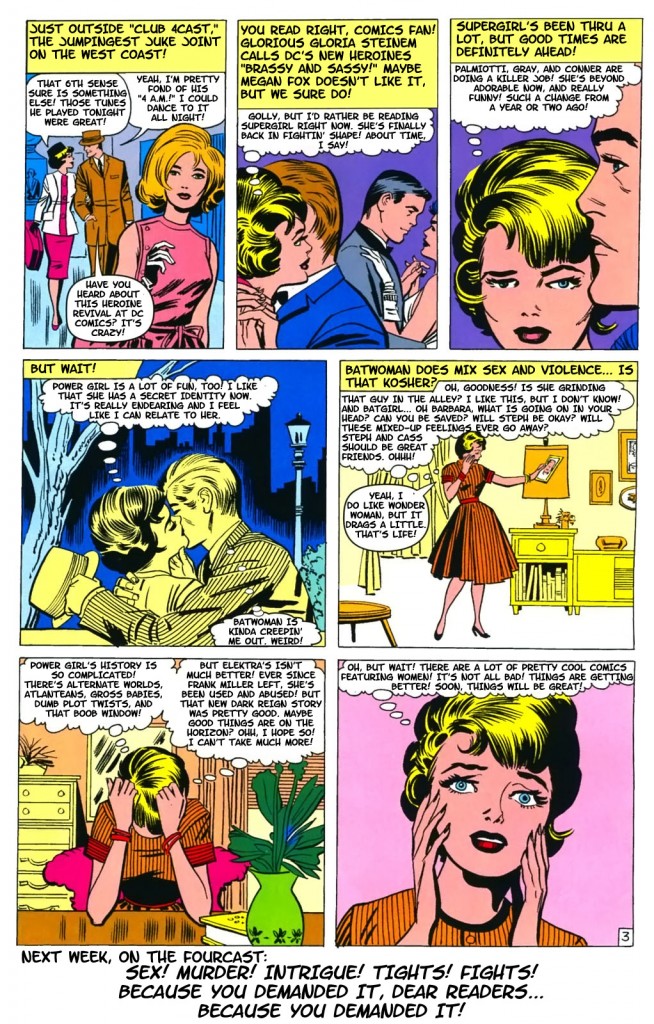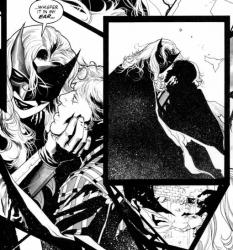Greg Rucka and Matthew Southworth’s Stumptown opens with two gunshots and ends with a revelation. What lies between those pages are clever world and character-building, a problem to be solved, the introduction of multiple threats to Dex, our heroine, a couple of reveals, and an all-around fine grasp of craft.
Stumptown feels like Ed Brubaker and Sean Phillips’s Criminal. Not in tone, of course, since Criminal is positively lurid at times, but in a more nebulous way. It feels like a book these guys are doing because they believe in it and enjoy it, rather than being paid by someone else to tell new stories about old characters. Though I will say that the lettering does remind me of Criminal, with its ragged edges and raw look.
Rather than resembling Criminal‘s “No way out but the hard way out” world, Stumptown feels much more like a Chandler novel, and Dex fits an oft-quoted Chandler piece:
The detective in this kind of story must be such a man. He is the hero; he is everything. He must be a complete man and a common man and yet an unusual man. He must be, to use a rather weathered phrase, a man of honor — by instinct, by inevitability, without thought of it, and certainly without saying it. He must be the best man in his world and a good enough man for any world.
Dex is flawed (she gambles), but she is also honest and caring and a woman of honor, as we see over the 35 pages of Stumptown. When confronted with someone who is scared, she reacts in a way that a hero should. Dex is just a little offbeat enough to seem real.
The characters Dex encounters in the book show that she’s been around for a while. It paints a picture of a shared history without being overbearing or too cute about it. Ansel, her brother, is well known around town, and many characters express concern about his welfare. It actually comes off a little like they don’t quite trust Dex all the way and want to be sure that she’s actually taking care of business. I like that Rucka left it open enough to give us some wiggle room to figure these things out.
The art’s good. Not great, but good. It’s pretty raw and scratchy, and reminds me quite a bit of Michael Gaydos. Southworth excels at conversation scenes and the use of space, giving Stumptown a very tense and claustrophobic feel. Places look and feel real. There’s a wide shot on a rich man’s house that looks excellent. However, Southworth’s not so great on action scenes, though those are few and far between in this issue. The scenes look a little too stiff, a little too posed, for my tastes.
I really like Southworth’s willingness to let the character’s faces do the acting. A crinkled eyebrow, slumped shoulders, and a sheepish smile go a very long way with me. My hands-down favorite panel in the book is the one where a character steps back into a doorway after leaving a room and places both hands on the doorframe. It speaks volumes.
Stumptown #1: it’s a good read and a good start to the series, with an engaging script by Rucka and solid art by Southworth. I could go for a more kinetic feel to the action sequences, but this doesn’t seem like that kind of book so far. If you like the feel of Gotham Central or Alias, this is basically what you’ve been waiting for since both of those were cancelled. Fans of Criminal should also be pleased, though this one’s on the opposite side of the law.



